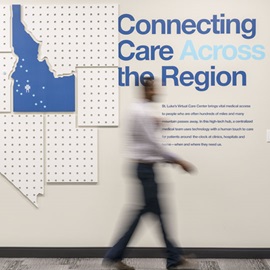Dr. Pate’s Prescription for Change
St. Luke’s maps growth trends to prepare for population boom

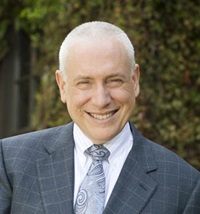
Part of St. Luke’s effort to transform care is to think as comprehensively as possible about how we make care accessible for a growing population and a growing number of patients with multiple chronic illnesses.
Access will increasingly take into account the roles of advanced practice professionals and extensivists, the use of technology and a variety of care settings, including care in patients’ homes. New facilities and extended hours are possibilities as well. Anticipating and planning for the future are ongoing for us at St. Luke’s; here with more is St. Luke’s Content and Communications Coordinator Alexis Bennett.
- David C. Pate, M.D., J.D.
Idaho and Nevada top the lists of the country’s fastest-growing states, and while the new neighbors are settling in to homes, schools and workplaces, St. Luke’s leaders and planners are busy building flexible health care for the area’s rapidly changing population.
Between July 2016 and 2017 alone, Idaho’s population grew by 2.2 percent, compared with national growth at 0.72 percent, according to the U.S. Census Bureau. The pace is not projected to slow; the population is expected to increase by 10 percent to 11 percent between 2017 and 2025.

An eight-year comparison shows considerable growth in need in certain areas of our region.
But it’s not just the young outdoorsy type that’s arriving by the dozens. The population age 65 and over is expected to increase by 40 percent. In some areas, such as Meridian, Eagle, Star and Middleton, this portion of the population is expected to double.
For a relatively young health system with a relatively healthy and stable universe of patients, the growing demand for services is contributing to a cascade of creative responses. St. Luke’s is, in effect, examining fundamental questions about what care is, where, when and how care is delivered – and who is most in need.
To visually understand the trends, the organization is increasingly turning to heat mapping. On the maps, population values are represented by colors; warmer colors indicate higher population density. Clinic locations and usage data then can be fed in and represented as spots and bars.
The visuals allow St. Luke’s to identify opportunities in areas that the system serves, reaching into eastern Oregon and northern Nevada, to prepare for a future that seems certain to mean more patients, more technology and more desire for convenience.
Becoming more nimble
The intent is to be nimble, adjusting how patients are seen to ensure they get the care they seek.
“We’re taking a perspective (to say), ‘Let’s understand the needs of the population and design the care that we’re going to deliver from a needs-based perspective.’ That starts way upstream,” said Dan Anderson, St. Luke’s vice president of strategy and planning.
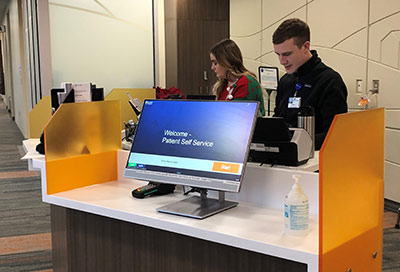
St. Luke’s is especially attentive to the trend in the older population. Because the aging process often is compounded by chronic conditions and cognitive impairment, anticipated growth in the 65 and older, Medicaid-qualifying population in areas such as Meridian, Eagle and Kuna and communities around Boise in the Magic Valley is shaping the types of clinics and services that the organization expects to plan for.
Because St. Luke’s is a community-owned and -governed asset, the organization’s leadership thoughtfully weighs all capital investments. Heat mapping creates a graphic focal point for conversations about the cost vs. benefit of building; St. Luke’s knows that its physical presence will continue to change and that there is also opportunity to improve processes and leverage technology in ways that can create new access points.
“There are underserved populations that don’t have access to a front door, so we need to create more,” said Dr. Jim Souza, St. Luke’s vice president and chief medical officer.
Given the rural nature of many of the communities St. Luke’s serves, specialty providers historically have visited areas around McCall, Wood River and west toward Oregon on a weekly basis. Alternative ways to see patients, including virtual visits and telehealth services, are likely to increase.
Refining approaches to care
Ongoing clinician shortages and St. Luke’s increasing focus on filling care gaps and creating a seamless continuum are additional dynamics that graphically play out on the heat maps. The organization also is trying to account for those patients who live every day teetering on the edge of inpatient admission. And while St. Luke’s will continue to look to beneficial partnerships within its communities to strengthen the care net, extensivist practices are an additional possibility in some settings and communities.
In this model, patients would transfer from a primary care provider to an extensivist provider at the point where the need to manage conditions and coordinate care intensify. An example might be a patient that by age 78 is experiencing three additional conditions, needing three medical specialists and likely taking additional prescriptions.
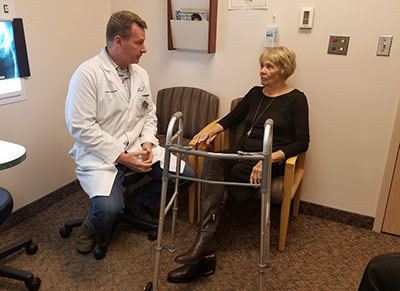
An extensivist clinic would combine physical and digital at-home support. Health measures could continually be monitored and sent through a central hub to a patient’s provider. In-person visits with the extensivist could happen several times per year in combination with other appointments, and specialists might be linked in through telehealth. Care planning could round out such visits.
“There’s much work going on to increase our operations, once patients get in the front door, so we can manage patients in a more efficient way,” Dr. Souza said.
Large circles on the heat maps represent areas where there is opportunity when it comes to access. In these areas, solutions are likely to be a combination of technology, training, appointment scheduling and staffing changes.
The data also illustrate the opportunity to accommodate patients in a timely manner as the number of patients increases and the number of clinicians doesn’t. St. Luke’s has begun to redesign its approach to primary care to offset this.
“If you redesign care into teams, the more simple, straightforward patients would likely see the advanced practitioners and the more complex cases in the patient panel would be handled by the physician,” Dr. Souza said.
Flexible planning, informed by improved data, will ensure St. Luke’s ability to meet patients’ needs, come what may.
“Providing all of these services in a meaningful way is what we mean by end-to-end continuum,” Anderson said. “If we’re going to be a partner in health and meet patient needs, we need to be able to do that across the board.”
About The Author
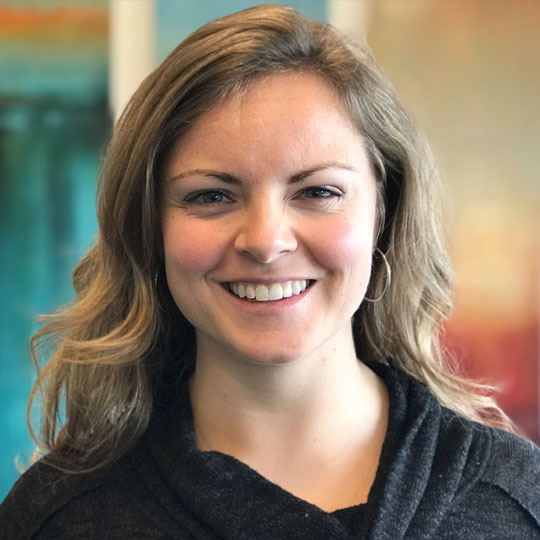
Alexis Bennett is a consultant for St. Luke's Community Health and Engagement.


